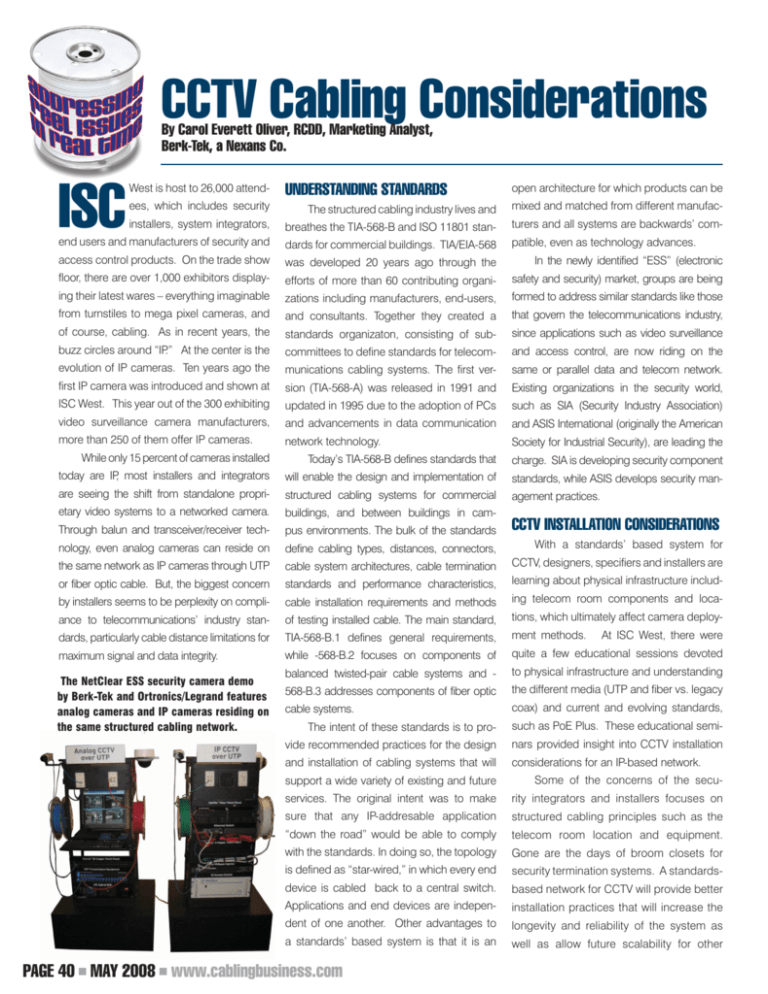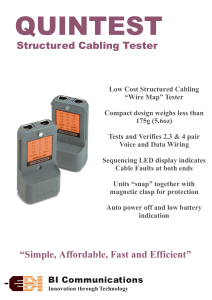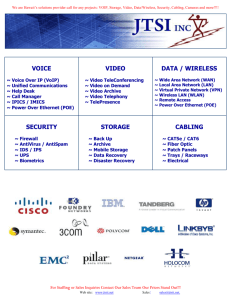CCTV Cabling Considerations - Berk-Tek
advertisement

CCTV Cabling Considerations By Carol Everett Oliver, RCDD, Marketing Analyst, Berk-Tek, a Nexans Co. ISC West is host to 26,000 attendees, which includes security Understanding standards open architecture for which products can be The structured cabling industry lives and mixed and matched from different manufac- installers, system integrators, breathes the TIA-568-B and ISO 11801 stan- turers and all systems are backwards’ com- end users and manufacturers of security and dards for commercial buildings. TIA/EIA-568 patible, even as technology advances. access control products. On the trade show was developed 20 years ago through the In the newly identified “ESS” (electronic floor, there are over 1,000 exhibitors display- efforts of more than 60 contributing organi- safety and security) market, groups are being ing their latest wares – everything imaginable zations including manufacturers, end-users, formed to address similar standards like those from turnstiles to mega pixel cameras, and and consultants. Together they created a that govern the telecommunications industry, of course, cabling. As in recent years, the standards organizaton, consisting of sub- since applications such as video surveillance buzz circles around “IP.” At the center is the committees to define standards for telecom- and access control, are now riding on the evolution of IP cameras. Ten years ago the munications cabling systems. The first ver- same or parallel data and telecom network. first IP camera was introduced and shown at sion (TIA-568-A) was released in 1991 and Existing organizations in the security world, ISC West. This year out of the 300 exhibiting updated in 1995 due to the adoption of PCs such as SIA (Security Industry Association) video surveillance camera manufacturers, and advancements in data communication and ASIS International (originally the American more than 250 of them offer IP cameras. network technology. Society for Industrial Security), are leading the While only 15 percent of cameras installed Today’s TIA-568-B defines standards that charge. SIA is developing security component today are IP, most installers and integrators will enable the design and implementation of standards, while ASIS develops security man- are seeing the shift from standalone propri- structured cabling systems for commercial agement practices. etary video systems to a networked camera. buildings, and between buildings in cam- Through balun and transceiver/receiver tech- pus environments. The bulk of the standards nology, even analog cameras can reside on define cabling types, distances, connectors, With a standards’ based system for the same network as IP cameras through UTP cable system architectures, cable termination CCTV, designers, specifiers and installers are or fiber optic cable. But, the biggest concern standards and performance characteristics, learning about physical infrastructure includ- by installers seems to be perplexity on compli- cable installation requirements and methods ing telecom room components and loca- ance to telecommunications’ industry stan- of testing installed cable. The main standard, tions, which ultimately affect camera deploy- dards, particularly cable distance limitations for TIA-568-B.1 defines general requirements, ment methods. maximum signal and data integrity. while -568-B.2 focuses on components of quite a few educational sessions devoted balanced twisted-pair cable systems and - to physical infrastructure and understanding 568-B.3 addresses components of fiber optic the different media (UTP and fiber vs. legacy cable systems. coax) and current and evolving standards, The NetClear ESS security camera demo by Berk-Tek and Ortronics/Legrand features analog cameras and IP cameras residing on the same structured cabling network. CCTV Installation Considerations At ISC West, there were The intent of these standards is to pro- such as PoE Plus. These educational semi- vide recommended practices for the design nars provided insight into CCTV installation and installation of cabling systems that will considerations for an IP-based network. support a wide variety of existing and future Some of the concerns of the secu- services. The original intent was to make rity integrators and installers focuses on sure that any IP-addresable application structured cabling principles such as the “down the road” would be able to comply telecom room location and equipment. with the standards. In doing so, the topology Gone are the days of broom closets for is defined as “star-wired,” in which every end security termination systems. A standards- device is cabled back to a central switch. based network for CCTV will provide better Applications and end devices are indepen- installation practices that will increase the dent of one another. Other advantages to longevity and reliability of the system as a standards’ based system is that it is an well as allow future scalability for other page 40 May 2008 www.cablingbusiness.com Reel Time Table 1: CCTV Systems, Distances and Recommended Products CCTV System Cable Connectivity Peripheral DVR Analog ≤328 ft with local power or midspan power Category 5e or 6 Copper patch cords, WAO, patch panel (midspan power ) Transceiver (balun) at camera midspan power Passive receiver IP ≤328 ft with PoE Category 6 or 6e Copper patch cords, WAO, patch panel DVR/NVR PoE Ethernet switch Analog >328 ft. with local power Enhanced Category 6 (non-IP) Copper patch cords, WAO, patch panels IP >328 ft. with local power Fiber optic cable Fiber termination panels, transceivers, ST connectors applications, such as access control. Going the distance…and beyond Of all the guidelines associated with structured cabling, the one that causes the biggest concern among security integrators is the Balun, transceiver Active receiver equipment DVR Media converters DVR/NVR structured cabling system, and stay within standards compliance. Table 1 is a guideline chart that maps out the distances and components needed to prepare for the IP conversion from analog. 100-meter distance limitation. We often hear Two important factors to note are, that through comments about cameras being able to run structured cabling, even with analog cameras, much further than the standards’ 100 meters. you can run analog video and futureproof your While this may be true for analog video, there system today to prepare for IP. The second are problems for IP systems over Ethernet is to make sure you are aware that if you run protocols. your copper (UTP) cabling over the 100-meter Let’s step back and look at why there is a distance for your analog camera, your camera distance limitation. When the standards were will work fine with proper transceiver (passive) being formalized, the committee members and receiver (active) equipment, but your infra- carefully looked at the maximum distance of the existing UTP cable (Category 3) and studied twisted pair copper cable at different distances and confirmed that at 100 meters there were no potential latency problems and signal integrity and attenuation levels were accept- structure will not be IP-ready. By adhering to the standards and selecting the right cabling, you will assure long-term reliability for any IP-addressable solution. able. And, as copper UTP cables were better manufactured to handle higher bandwidths and speeds and emerging Ethernet protocols (from yesterday’s 10BASE-T to today’s 10GBASE-T), one of the benefits of standards is that they are backwards’ compatible. Hence, the 100-meter rule lives on. But there are approved cables and practices to run beyond the 100 meters over a “Reel Time” addresses cable topics including both copper and fiber constructions, applications, installation practices and standards updates. If you have a particular cable issue, please send an E-mail to: carol.oliver@nexans.com and we will feature the solution in an upcoming issue www.cablingbusiness.com May 2008 page 41 Circle Reader Card #140





